Are you still planning manually?
Are you still manually planning routes? It’s time to stop and save up to 50% of direct and indirect costs in your delivery or field service operation.
Home > Blog > Scheduling and Route Optimization Software
Route OptimizationWe take a look at the relationship between delivery scheduling and route planning, and how it all comes together in route optimization software.
In this post, we take a look at the relationship between delivery scheduling and route optimization.
You’ll see the problem and the truth behind it, and how it all comes together. (in route optimization software)
You’ll find out why you can’t have a successful last-mile delivery without one or the other.
And how, despite their differences, both complement each other to benefit your operation.
So, if you want to know more about all of this, you’ve come to the right place.
Let’s start.
Are you still planning manually?
If you are, then you are well aware of this problem.
Manual route optimization and scheduling is a catch-22.
You can’t create routes without delivery times and ETAs. And you can’t have effective schedules without knowing where drivers have to go.
Technically, you can. But you will frustrate customers with long wait times, or drivers will waste too much time (and fuel) to fulfil orders.
That’s why route planners are such a valuable asset to a delivery operation.
But it’s also why companies that rely on manual scheduling and route planning either have fixed routes or fixed schedules.
With fixed routes, drivers visit the same locations regularly. That works if customers require recurring drop-offs at regular intervals. Think postal services.
But that’s highly unlikely when talking about a regular business, like yours.
Fixed routes create quite a lot of waste at scale since you’re missing out on a lot of opportunities for optimization.
The same logic applies to fixed schedules.
Using fixed schedules means drivers will have to cover greater distances when moving from one destination to the next.
But what’s more, if something unexpected happens, the entire schedule is compromised.
And that means missed deliveries and a lot more overtime for drivers. (Which is frustrating for both sides of the aisle)
And in the modern on-demand delivery landscape, this makes no sense.
The problem with manual planning, then, lies in the disconnect between scheduling and route optimization.
It’s time to stop planning schedules and routes by hand and bring the two back together.
When you want to understand how delivery scheduling and route optimization integrate, think of it this way.
Here’s the view when it comes to manual delivery planning. That’s the wrong approach:
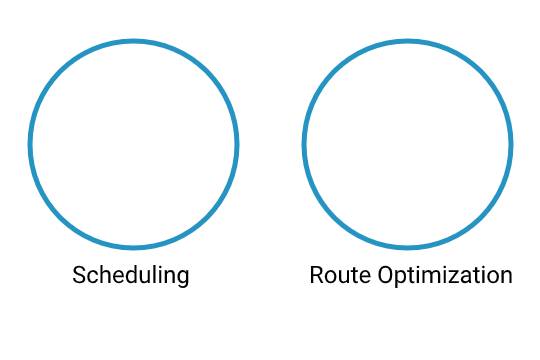
Now, here’s the right way of viewing it:
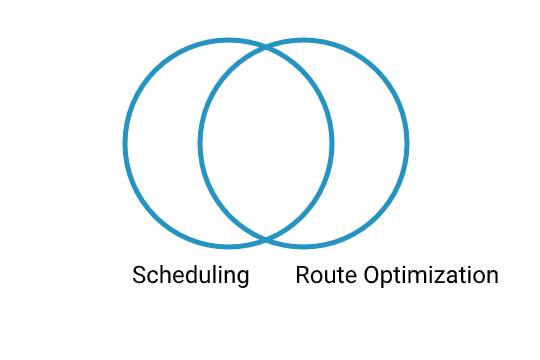
They overlap.
Where they overlap should be your focus area.
It’s the sweet spot where each route and schedule can maximize output and minimize waste.
That’s also where delivery optimization happens.
But before we tell you how they come together, let’s first take a look at what makes them different.
As you know, delivery scheduling and route optimization are different from one another in a few vital areas.
And while they have points of distinction, you can’t entirely separate them. Last-mile delivery relies on both to be effective and successful.
But rather than highlight each distinctive feature of the two, we want to point out a core contrast:
They give you the context for the when, where, and how of each delivery.
(You already know the what and the why)
This is the way the two converge:
Now, let’s how to combine it all.
Another way to look at it is like this:
Delivery scheduling makes demands. Route planning fulfils those demands. While optimization maximises the efficiency of both.
Technically, route optimization is what enables you to make better use of available resources and maximise your capacity.
You can also think of it as a relationship between two people.
There will be giving and taking. And in some cases, a compromise.
Both of these components come together with route optimization software.
If we use the same metaphor as before, then the software is the place where the relationship can flourish.
But we need to dive even deeper.
Let’s take a look at exactly how scheduling and routing complement one another.
When order requests arrive, delivery scheduling and route planning work hand-in-hand to fulfil them.
On the one hand, creating delivery schedules help you to understand when the customer needs the order to arrive.
You have a specific number of orders that have to arrive by a specified date and time. That’s a delivery schedule.
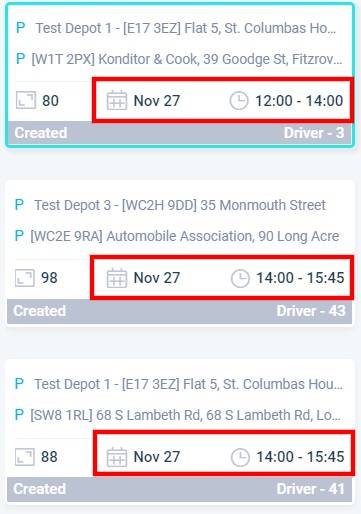
On the other hand, route planning helps you to deliver all those orders until the specified time.
You have a fleet of vehicles and drivers that have to drive to each location by the time marked in the schedule. That’s route planning.
Route optimization is the most effective and efficient way to reach each of those destinations by that time.
Here’s an example of how that looks:
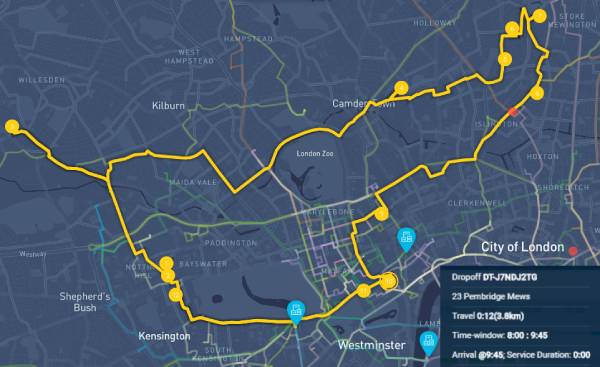
Without either one, you won’t be able to know what you need to do, when you need to do it, and how you’re going to get it done.
Time is a HUGE issue in modern delivery.
So much, in fact, that people don’t mind paying a delivery fee if it means they will get their goods sooner than expected.
And how soon is soon?
Statistics say that 55% of people want same-day delivery (currently the fastest delivery option on the market).
And despite what you might think, it is possible to offer same-day delivery even if you aren’t a retail giant like Amazon, Walmart, and Target.
But that’s where the success of these powerhouses comes from speed, convenience, and quality customer service.
So, if you want to know how to compete with Amazon delivery, for example, all you need to do is co-exist with them.
But what does this have to do with scheduling and routing?
The answer: A lot.
When you take a look at a quality delivery schedule, its purpose is to order tasks so that you complete each delivery on-time.
If you can do it sooner than expected, that’s even better both for your customers and your last-mile delivery operation.
That’s where route optimization steps in.
The goal of route optimization isn’t only to map routes with multiple stops, so drivers get there on time.
It’s also to cut the time it takes to cover the distance between stops.
Doing so allows you to build an agile delivery, which achieves two things:
By cutting the time it takes you to complete a life cycle of each delivery (from order to arrival), route optimization helps you to maintain the timeliness of your schedule and delivery operation.
Unless you are a 24-hour post and parcel carrier or 3PL provider, there is a limit to how many deliveries you can complete within a day.
Despite the demand, you can only fulfil as many orders as your operational capacity allows it.
In terms of time, these constraints include:
But it also has to do with the physical capacity of your fleet:
When you combine all of your assets with the time constraints, you can mark up the capacity of your last-mile delivery.
And based on that information, you can only schedule as many deliveries as the capacity allows.
But that’s where route optimization comes into play.
With better route planning, you can make better use of your assets and resources.
All you have to do is look at the primary function of routing software, which is, of course, automated route optimization.
That feature can reduce the drive time to a drop-off location, and cut the time per delivery for each driver in your fleet.
And the software does this not by creating the shortest path between two points on the map.
Instead, it takes into account multiple factors like drop-off locations, the geography of the delivery area, traffic congestion, and others.
Which means route optimization creates routes that take the least amount of time to cover based on the schedule, external factors, and the physical capacity of your fleet.
That reduces the time per delivery and makes better use of all available resources.
And that means you can increase the output and performance of the fleet, and expand the limit of your last-mile delivery (or how many orders you can fulfil per day).
How do you start planning a delivery schedule? What orders come first?
Are all drop-offs equal? Or do some have precedent over others?
If you’ve ever planned last-mile operations, then you know that some customers, orders, or drop-offs come first.
Even with fixed routes, you always have higher and lower priority deliveries in terms of when you deliver them.
And with modern fulfilment and the state of delivery in time of the coronavirus, that difference has increased.
Specifically, more companies now offer different delivery options:
You may already offer some of these.
If that’s the case, then you know that same-day delivery has priority over standard delivery, which has precedence over free delivery.
But at the same time, you need to consider the location.
What if a (priority) address is beyond your usual delivery area? Or you’ve planned depot sites outside the range of operation?
Are you going to send drivers from one end of the city to another because of a priority delivery?
Probably, NOT.
Instead, you will first prioritize deliveries from most to least important and see when you need to deliver each one.
Then, you will take a look at the map to see where each drop-off address is.
If a driver has to cover a decent distance to fulfil a priority order, with enough time to complete 2-3 other drop-offs that are en route to the location, then you should schedule those deliveries first.
In this scenario, route density helps you to make a much more cost-effective delivery schedule.
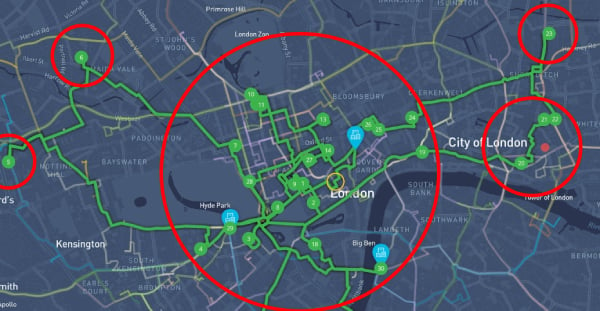
While route optimization ensures each driver takes the shortest path from A to B to C to D, so all of them arrive on time. (Including the top priority order)
Here’s another feature of delivery schedule planning: ETAs (expected time of arrival).
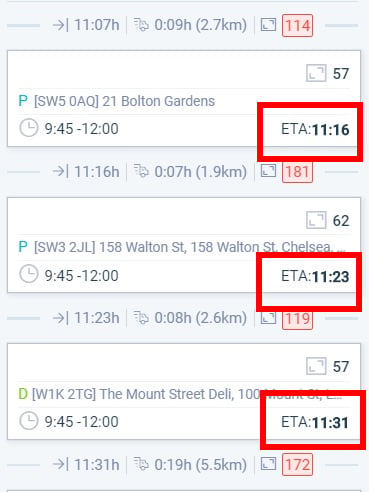
No one would argue that ETAs aren’t central to the delivery experience.
Customers want to know where their orders are, and particularly when they will arrive.
Dispatchers and operations managers want to know if all deliveries are running smoothly, and according to schedule.
Not to mention, they want to know whether there is room to squeeze in a few extra orders.
So, the more accurate ETAs are the bigger your positive impact on customer satisfaction. And the more room you have to incorporate delivery tactics to grow your operations.
But relying on scheduling to calculate precise ETAs isn’t enough.
Without routing, you can’t count on the exact travel time to destination.
However, even with manual route planning, you can only rely on distance, key metrics in delivery logistics and average values. And that’s not very accurate.
So, you need to automate the process. That’s where the software comes in.
First, route optimization software relies on real-time mapping via geocoding.
The software generates routing maps using minute-to-minute updates.
That allows you to calculate the distance from one stop to the next with greater accuracy.
Which means greater precision when you’re determining the travel time to each location.
The system also uses live vehicle or driver tracking, which allows it to recalibrate ETAs in real-time.
For example, if a driver encounters traffic, the system can account for the extra time and change the time of arrival on the customer’s tracking link.
But it also works when a driver completes his drop-off ahead of schedule.
Thankfully, you can use route optimization software to set up custom notifications.
So, if a driver is early, the customer will be aware of it ten or fifteen minutes before the drop-off.
And that’s what helps your drivers stay on track with each stop on their route.
We could continue discussing the topic on and on, but at this point, it’s clear: Delivery scheduling is all about route optimization. And route optimization is all about planning better delivery schedules.
So, we’ll leave you with these two takeaways:
But we’re here to help.
We have everything you need to start improving your delivery.
Are you still manually planning routes? It’s time to stop and save up to 50% of direct and indirect costs in your delivery or field service operation.
Looking for a route optimization solution for your business? Here are 7 essential components you mustn’t overlook if you want the best route planner.
Learn how to plan a route with multiple stops on Google Maps and other tools in 2024. Step-by-step tips to make route planning simple and efficient.
Be the first to know when new articles are released. eLogii has a market-leading blog and resources centre designed specifically to help business across countless distribution and field-services sub sectors worldwide to succeed with actionable content and tips.
